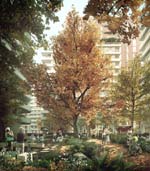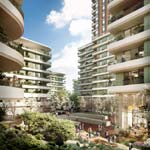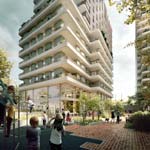
|

|
|
Home Site Search Contact Us Subscribe
|
|
Building for the Next Generation #1: Covid-19 and a New Era for Public Spaces With the right strategy and balance of accessibility, safety, and sustainability, the public realm can play an important role in smoothing the transition from lockdown to normality. By Richard Hyams November 5, 2020 EDITOR’S NOTE: This is the first in a new series penned by Richard Hyams, founder and director of London- and Lisbon-based astudio.
The role of the public space has never been so important. Through the lockdown experience, many people have learned the value that society and the outside gives them. However, with so much time in lockdown, many people are facing “reopening anxiety,” where being in crowded places is discouraging them from leading their normal lives.
The public realm can play an important role in smoothing the transition from lockdown to normality. With the right strategy and balance of accessibility, safety, and sustainability, we can establish a “new era” for the public realm, uniting communities and creating a renewed sense of value in public spaces.
Bringing people back to the community
Lockdown allowed us to appreciate being in the outside world, highlighting the importance of the public realm to community use. This has accelerated the global trend to people-centric spaces, where planners recognize the benefits of less congestion and pollution, and the community is able to gather safely.
Certainly, this change has already started happening. Before Covid-19, cities and towns across the world have been investing in the community. For example, the reopening of Place de la Republique in France established a greater emphasis on open space for public gatherings. Meanwhile, pedestrianized cities like Auckland, Cologne, and Denver, along with the planned pedestrianization for Oxford Street, London, are overhauling urban mobility in favor of community experience. Covid-19 has also allowed city officials and local government decision makers to review traffic and mobility, most recently causing Milan to ban cars from the inner city to improve air quality and city dweller satisfaction.
Not only does a renewed focus on people-centric spaces improve a town or city’s environment, it can also improve the ability to social distance as people return to normality. By thinking more intelligently about the needs for our open spaces, such as safe shop queues, outside areas for cafes and restaurants, and a focus on pedestrianizd zones, improved safety and quality of space can be achieved, helping to boost local economies through improving demand and supporting jobs.
Sustainability
While many people have avoided crowds and densely populated spaces owing to the fear of contamination, planners are faced with finding the balance between safe spaces and the benefits of large communities. For example, while there may be health risks and environmental downsides associated with high-density spaces, the larger the community, the stronger the economy can be.
In order to get the balance, planners and designers should be looking to maximize green spaces. While green space in London has been shrinking, now to 26% of London’s 800 square kilometers (300+ square miles), people are expressing a preference for this type of space owing to the improved air quality and the renewed desire to be outside. Presenting greater biodiversity in densely populated cities can remove pathogens in the air and reintroduce species important to the ecosystem.
Certainly, it seems that cities are too densely packed to support urban greening. Innovative responses are required. For example, New York City invested in the High Line project, introducing a matrix of wildflowers, trees, and shrubs on a pedestrian-only elevated walkway. Recently, the shortlist for the Camden Highline competition to deliver greening to a disused stretch of railway viaduct in the London borough of Camden was announced. The 1.2-kilometer-long (0.7-mile) route will touch on 20,000 people’s lives. At the same time, smaller scale endeavors, such as the greening of rooftops and façades, offers a further means to not only deliver environmental benefits, but also wellbeing benefits for local residents.
At astudio, we tested and modeled the public spaces for our Ebury Bridge Estate regeneration project in Westminster, London, using environmental testing software, which took place simultaneously to the development of the building designs. As a result, we have been able to create improvements to daylight quality at peak times of year, as well as enhancing the quantum and quality of outside space, in addition to providing of new affordable homes.
The socially distanced city
While we can’t simply widen roads and pathways throughout towns and cities to encourage social distancing, planners have the opportunity to get creative and make use of what’s already there. While New York’s High Line made use of an old railway – an option that isn’t readily available in most cities – planners can be looking at other options, including shared surface design. This approach creates a hierarchy of structured movement corridors that can manage street use in favor of pedestrians and cyclists.
To achieve this most successfully, urban planners can use AI/VR to radically rethink the design and regeneration of public spaces that allows social distancing to be planned into long-term designs. They can also think about using heat map technology to understand people’s movement and make plans accordingly.
Adaptable spaces
While we currently focus on social distancing, the next few years will be subject to a great variety of change in the fallout of Covid-19. In order to best accommodate this, flexibility will become increasingly important. Community facilities may need to flex up or down to accommodate social distancing and outdoor trading, for example.
Adding the measure to scale up or scale down will allow spaces to adapt to new government policies without wasting expensive resources. One of the most effective approaches to flexibility can be found in offsite construction. This method offers a scalability that can be used to address a need for high-quality temporary spaces, such as restaurants, cafes, and healthcare facilities such as the Nightingale Hospitals.
The transition to normality
As we all move into the unknown territory of the post-Covid world, it is important that we do not forget what we’re learning throughout the course of this pandemic. Safety and community have each played a crucial role in helping us get through the lockdown, and we can build on this understanding to create the future cities, towns, and public spaces that enhance the world outside our homes.
By putting people at the heart of the urban planning agenda, and considering the longer-term value of adaptability and sustainability, we can invite people to take part in their community, creating a more vibrant, diverse, and inviting future for all.
Richard Hyams is director of London- and Lisbon-based astudio, which he founded in 2007. The firm is committed to research-based design, working mainly in dense urban environments, which led to being named Building Magazine’s Architectural Practice of the Year within its first five years. Hyams is championing the debate about and pioneering the design for the development of efficiently built, cost-effective housing as a way to tackle the U.K.’s housing crisis. Prior to founding astudio, he spent 12 years at Foster + Partners, where he was a project director across multiple projects spanning cultural, office, and residential projects.
|
(click on pictures to enlarge)  astudio Ebury Bridge Estate regeneration project, Westminster, London  astudio Ebury Bridge Estate: Using environmental testing software resulted in improvements to daylight quality and enhanced quantum and quality of outside space.  astudio Ebury Bridge Estate: The importance of outdoor space in urban settings has taken on new importance for London’s residents during pandemic lockdowns.  astudio The Ebury homes project addresses the urgent need for more affordable housing in the U.K. Capital. |
© 2020 ArchNewsNow.com